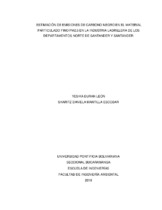| dc.contributor.advisor | Magara Gómez, Kento Taro | |
| dc.contributor.author | Durán León, Yesika | |
| dc.contributor.author | Mantilla Escobar, Sharitz Daniela | |
| dc.coverage.temporal | 2018 | |
| dc.date.accessioned | 2020-04-15T15:44:12Z | |
| dc.date.available | 2020-04-15T15:44:12Z | |
| dc.date.issued | 2018 | |
| dc.identifier.uri | http://hdl.handle.net/20.500.11912/5179 | |
| dc.description | 99 páginas | spa |
| dc.description.abstract | Con el fin de determinar las emisiones de Material Particulado Fino (PM2.5) y Carbono Negro (BC por sus siglas en inglés) para el sector ladrillero, se llevaron a cabo dos muestreos en empresas ladrilleras seleccionadas con diferente tecnologia, ubicadas en los departamentos de Santander y Norte de Santander, mediante un equipo isocinético diseñado específicamente para tomar muestras de Material Particulado Fino. Adicionalmente, se solicitó a la Corporación Ambiental Empresarial, información de un muestreo isocinético realizado en Cundinamarca en un horno ladrillero artesanal con el fin de comparar los tres tipos de tecnologías más usados en Colombia (Continuo, intermitente y artesanal). Se estimaron las emisiones promedio de BC, en un horno continuo (0.5896 g BC/h), horno intermitente (40.8915 g BC/h) y horno artesanal (0.3362 g BC/h) y para PM2.5 en horno continuo (7.8445 gPM2.5/h), horno intermitente (113.02257 gPM2.5/h) y horno artesanal (61.5938 gPM2.5/h) a partir de la relación de los factores de emisión de combustible promedio de cada uno de los contaminantes por la tasa de consumo de combustible. Se encontró que el horno Hoffman de tecnologia continua consume menos combustible manteniendo su alta producción. Adicional a esto los valores de emisión y concentración resultaron muy bajos a comparación del horno Colmena y Fuego Dormido, considerándose así la mejor tecnologia. Es recomendable que las empresas que utilicen hornos de tecnologia artesanal, consideren mejorar su tecnología a una intermitente y las empresas que trabajen con una tecnología intermitente, mejorarla a una continua. En las empresas en las que el cambio de tecnología resulte dificil, se recomienda que la temperatura, alimentación de combustible y oxigeno se realicen de manera controlada, y de esta manera disminuir las emisiones de PM2.5 Y BC. | spa |
| dc.description.abstract | In order to determine the emissions of Fine Particulate Matter (PM2.5) and Black Carbon (BC) to brick sector, two samplings were carried out in selected brickworks companies with different technology, located in Santander and Norte de Santander departments, by isokinetic equipment designed specifically to take samples of Fine Particulate Matter. Additionally, we requested the information of an isokinetic sampling carried out in Cundinamarca in an artisanal brick kiln at CAEM in order to compare the three most used technologies in Colombia (Continuous, intermittent and artisanal) The average BC emissions were estimated, in a continuous kiln (0.5896 g BC / h), intermittent kiln (40.8915 g BC / h) and artisanal kiln (0.3362 g BC / h) and for PM2.5 in continuous kin (7.8445 g PM2 .5 / h), intermittent kiln (113.02257 g PM2.5 / h) and artisanal kiln (61.5938 g PM2.5 / h) from the ratio of the average fuel emission factors of each of the pollutants by the rate of fuel consumption. According to the results, the Hoffman continuous kiln technology, consumes less fuel while keeping its high production. In addition to this, the emission and concentration values were very low compared to the intermittent and artisanal kins, thus being considered the best technology. We recommend that companies that use artisanal technology ovens, consider improving their technology to an intermittent and companies that work with an intermittent technology, improve it to a continuous one. In companies where the change of technology is difficult, it is recommended that the temperature, fuel supply and oxygen are made in a controlled manner, and thus reduce PM2.5 and BC emissions. | eng |
| dc.format.mimetype | application/pdf | |
| dc.language.iso | spa | |
| dc.publisher | Universidad Pontificia Bolivariana | spa |
| dc.rights | Attribution-NonCommercial-NoDerivatives 4.0 International | * |
| dc.rights.uri | http://creativecommons.org/licenses/by-nc-nd/4.0/ | * |
| dc.subject | Ladrillos | spa |
| dc.subject | Santander (Departamento / Colombia) | spa |
| dc.subject | Norte de Santander (Departamento / Colombia) | spa |
| dc.subject | Carbón | spa |
| dc.subject | Temperatura | spa |
| dc.title | Estimación de emisiones de carbono negro en el material particulado fino pm2.5 en la industria ladrillera de los Departamentos Norte de Santander y Santander | spa |
| dc.type | Trabajo de grado | spa |
| dc.publisher.department | Escuela de Ingenierías | spa |
| dc.publisher.program | Ingeniería Ambiental | spa |
| dc.type.hasVersion | publishedVersion | spa |
| dc.description.sectional | Bucaramanga | spa |
| dc.description.degreename | Ingeniero Ambiental | spa |


